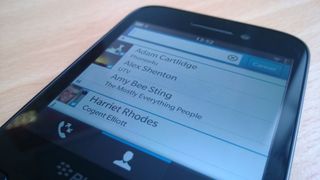Display
BlackBerry has opted to use a 3.1in IPS display on the Q5, instead of the Super Amoled technology used on the Q10. Visuals on the 720 x 720 pixel resolution screen are still top notch with great contrast and vibrant colour.
Despite the good responsiveness, the small screen can be a let-down. The Q5 is not ideal for multimedia consumption or internet browsing which is what mobile devices are used for a significant portion of the time. Its square nature means that you'll get black bars at the top and bottom of the image when watching video content and extended viewing sessions become uncomfortable because of the scale of what you're watching.
It's clear the Q5 is designed for one primary purpose - email and instant messaging. This is likely to relegate it to a secondary device for business users or make it appealing to teenagers who want to keep in touch with friends via BBM.

Operating System
We've already touched on the BlackBerry 10 platform that powers the Q5 earlier on but it's worth revisiting. Such is the extent of the overhaul carried out by BlackBerry that even users of legacy devices could face a steep learning curve.
Navigation is carried out in a completely different way using swipe gestures and apps and functions glide into one another in a concept that BlackBerry calls 'BlackBerry Flow'. It aims to mimic the interface of desktop GUIs in that each thing you have open is laid out in front of you - much like the multitasking view on Android Ice Cream Sandwich and upwards - with swipes taking you in and out of apps.
The lack of a 'home' button may puzzle some users - but a flick from the bottom of the bezel upwards replicates this function and it doesn't take long to get used to it. Other additions to the OS include improved BBM functionality that now enables video calling and screen sharing. The latter makes sharing presentation slides and the like easier during conference calls, however, the limited screen space doesn't make it viable.

Elsewhere, the BlackBerry Hub shows up again and groups together interactions from contacts, social media accounts including LinkedIn, text messages and emails.
BlackBerry Balance is built in too. This partition within the OS allows IT admins to separate personal and work data. In the event an employee does leave the company and wants to take the handset with them, IT admins can simply wipe the enterprise part of the device, without affecting personal information.
Internals
A 1.2GHz Qualcomm Snapdragon processor is the life-force behind the BlackBerry Q5. Performance is almost identical to the high-end Q10, which has a slightly faster 1.5GHz processor. The difference is minimal in part thanks to the 2GB of supporting RAM included in the Q5.
Internal storage is pegged at 8GB (half that of the Q10) but can be expanded via micro SD up to 32GB and a 2180mAh Li-Ion power cell ensures the device has the stamina to withstand juice-draining activities such as video streaming and downloading for longer than its contemporaries.
Data connectivity options include 4G LTE and HSPA+ for data, as well as Bluetooth 4, Wi-Fi, NFC and GPS. The increasingly common MHL support is lacking and so mirroring the devices interface on a connected TV is not possible and pushing video to bigger screens must be done via DLNA.
Overall
Aimed squarely at the mid-range market, the BlackBerry Q5 does well to take the performance offered by the high-end Q10 and wrap it up in an affordable package.
However, factor in the small screen, poor camera and lack of 'big name' apps from BlackBerry World and business users may be disappointed.
Verdict
With decent performance levels and a mid-range price, the Q5 is reasonable handset. However, it's suited more to the consumer market and is unlikely to anything more than a secondary messaging device for most business users due to the small screen.
OS: BlackBerry 10
Processor: 1.2GHz dual-core
Memory/Storage: 2GB RAM/8GB expandable up to 32GB via microSD
Screen: 3.1in IPS LCD (720 x 720) display, 328 ppi
Connectivity: Wi-Fi 802.11 b/g/n, Wi-Fi hotspot, A-GPS, Bluetooth 4.0 (A2DP)
Other: Accelerometer, proximity sensor, compass
Bands: 2G GSM 850 / 900 / 1800 / 1900, 3G HSDPA, 4G LTE
Camera: 5MP rear, 2MP front-facing
Battery: 2180 mAh Li-Ion
Size: 120 x 66 x 10.8 mm (WxDxH)
Weight: 120g

